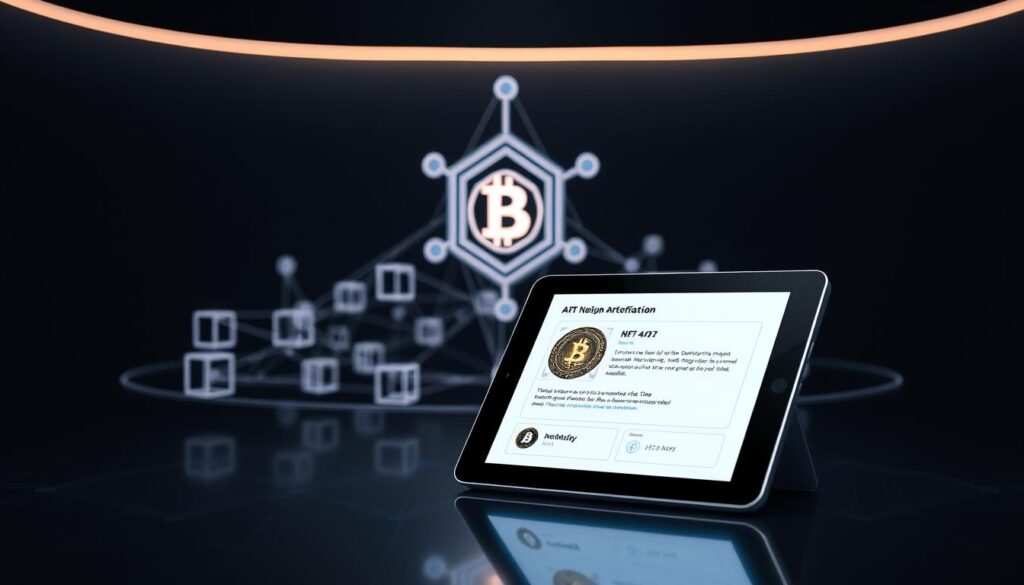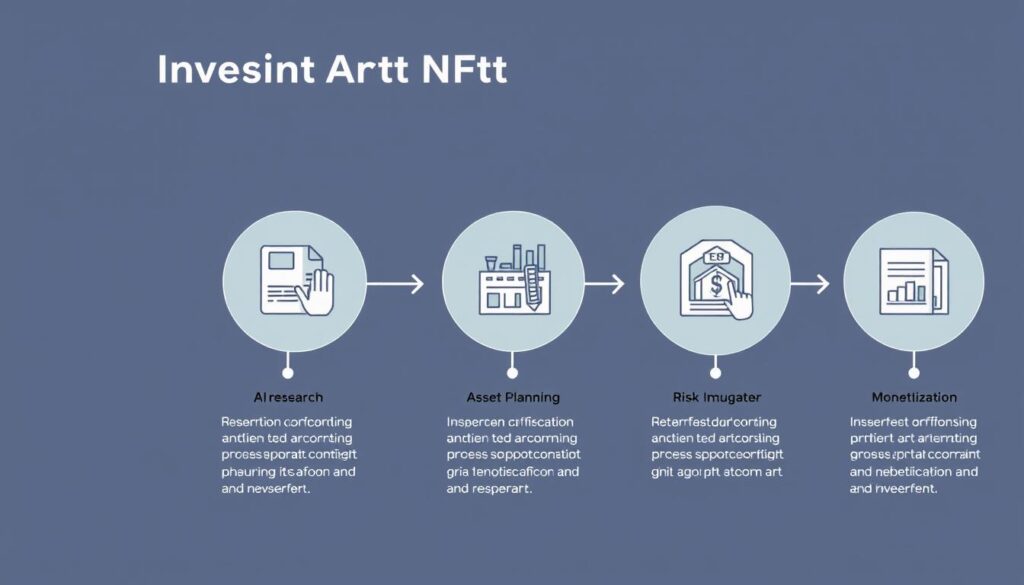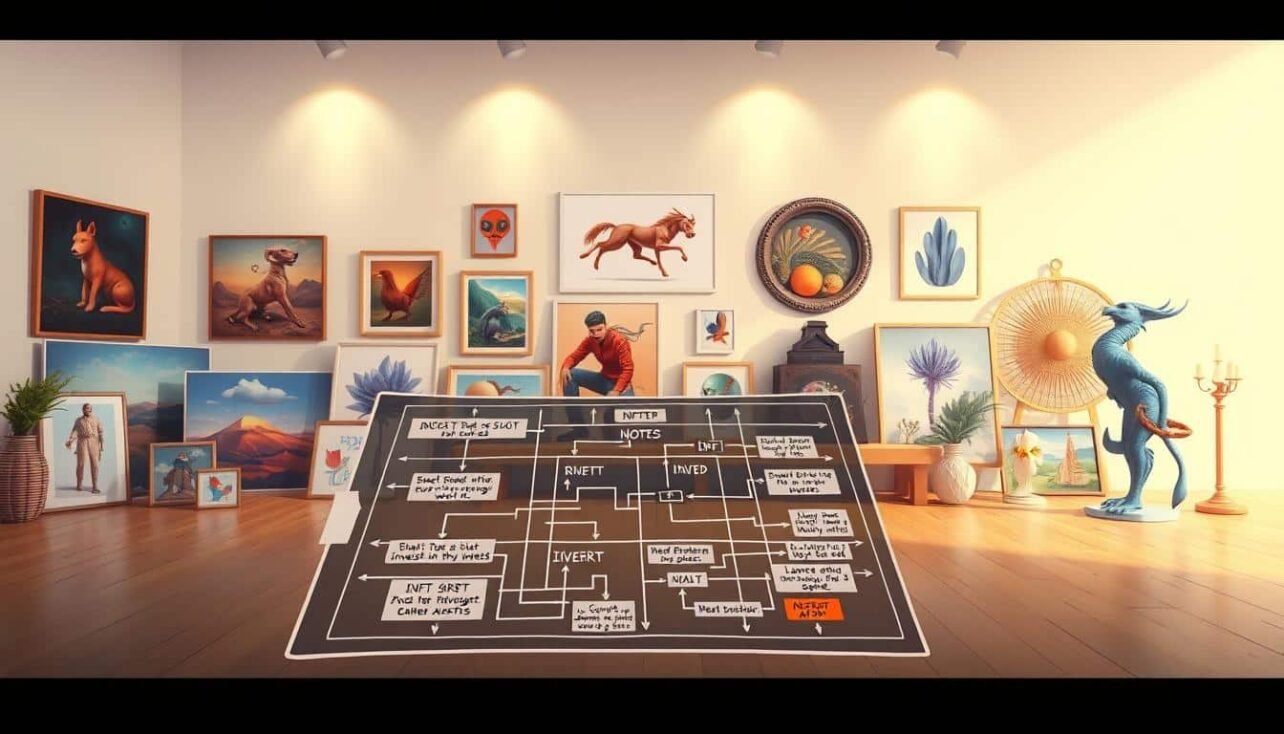The way we value creative work is changing rapidly. A single digital collage sold for $69.3 million at Christie’s in 2021, sparking conversations about ownership in the internet age. This shift centers on blockchain-powered tokens that verify authenticity—even when files can be copied endlessly.
These tokens create scarcity for digital items through unique identifiers stored on decentralized ledgers. Over $25 billion worth traded hands last year alone, showing explosive interest from both enthusiasts and institutions. Major auction houses now host dedicated sales, while athletes and musicians launch their own projects.
Why would someone pay millions for something freely viewable online? It combines provable ownership with cultural status. Collectors gain exclusive rights to original files and often unlock special perks. The technology also empowers creators through automatic royalty payments on resales.
Key Takeaways
- Blockchain tokens create verifiable ownership for digital files
- High-profile sales demonstrate growing mainstream acceptance
- Scarcity drives value despite online accessibility
- Creators benefit from built-in resale royalties
- Market growth accelerated by institutional participation
Understanding the Basics of Digital Art and NFTs
Imagine owning a one-of-a-kind certificate for a file everyone can download. This paradox lies at the heart of non-fungible tokens, which transform easily copied files into authenticated assets. Unlike cryptocurrencies, these tokens carry unique identifiers that verify ownership through decentralized ledgers.
What Are NFTs and How Do They Work?
NFTs use blockchain to create permanent ownership records. Each token acts like a digital fingerprint, storing details about its origin and transaction history. Vitalik Buterin first explored this concept in 2012 with Bitcoin-based “colored coins,” laying groundwork for today’s Ethereum-powered ecosystem.
Think of it like owning van Gogh’s original painting versus a poster print. The artwork remains viewable to all, but only one person holds the authenticated masterpiece. Blockchain ensures this distinction remains tamper-proof, even as files spread online.
Digital Art in the Blockchain Era
While visual pieces dominate headlines, tokens now represent music albums, virtual land parcels, and gaming items. Artists embed royalty clauses into smart contracts, earning percentages on secondary sales automatically. This system shifts power from platforms to creators, fostering new economic models.
Platforms like Ethereum and Solana host diverse collections, each with unique verification methods. As blockchain evolves, so does its capacity to authenticate increasingly complex assets—from 3D animations to AI-generated works.
The Unique Value Proposition of NFTs in the Art World
Originality verification in the digital realm has always been a puzzle. Blockchain tokens solve this by embedding unforgeable proof directly into creative works. This breakthrough reshapes how we assign worth to intangible assets.

Proof of Authenticity and Ownership
Every token contains a cryptographic fingerprint stored across thousands of computers. Unlike paper certificates, these records can’t be altered or duplicated. When art collectors acquire pieces, they receive irrefutable evidence of legitimacy.
Creators maintain control through programmable smart contracts. These agreements automatically enforce royalty payments, ensuring compensation continues through resales. The system bypasses traditional gatekeepers who often take 40-60% commissions.
| Aspect | Traditional Verification | Blockchain Verification |
|---|---|---|
| Record Storage | Centralized databases | Decentralized network |
| Accessibility | Limited to institutions | Publicly verifiable |
| Tamper Resistance | Vulnerable to forgery | Immutable ledger |
| Royalty Management | Manual tracking | Automated payments |
Transferability and Scarcity
Moving assets between owners takes seconds through digital wallets. Physical art requires insurance, shipping, and authentication – processes that often take weeks. Tokenized items retain their provenance history during transfers.
Limited editions gain worth through controlled supply. A creator might release 100 numbered copies, with each subsequent sale increasing rarity. This model mirrors collectible markets but adds transparency through visible transaction trails.
Navigating NFT Marketplaces and Investment Platforms
Transactional efficiency separates leading platforms from the rest. Over 80% of all tokenized asset activity occurs through five major venues, each catering to distinct collector needs. Understanding these ecosystems helps buyers allocate funds strategically.

Exploring Leading NFT Marketplaces
OpenSea dominates trading volume with its vast inventory of 10 million+ items. Curated spaces like Nifty Gateway focus on premium releases from established creators. Traditional auction houses now compete – Christie’s hosted a $121 million sale in 2022.
Specialized venues thrive by targeting niche audiences. NBA Top Shot transformed basketball highlights into $1 billion in sales. These platforms simplify discovery through tailored interfaces and verified collections.
| Platform | Focus | Fees | Audience |
|---|---|---|---|
| OpenSea | General | 2.5% | Mass market |
| Nifty Gateway | Premium art | 5% + gas | High-end collectors |
| NBA Top Shot | Sports moments | 5% | Fans |
| Christie’s | Auction-based | Variable | Institutional |
Managing Transactional Costs and Gas Fees
Ethereum network fees fluctuate based on demand. A $50 purchase might require $200 in gas during peak times. Savvy traders use fee trackers like Etherscan and schedule transactions during off-peak hours (typically Sundays).
Some platforms absorb gas costs through layer-2 solutions. Polygon-based marketplaces process trades faster with fees under $0.01. Always verify wallet compatibility before initiating transfers – mismatched networks can lock funds.
For deeper insights into evaluating platforms, explore our comprehensive guide covering security protocols and emerging alternatives.
Digital art NFT investment guide for beginners and collectors
Entering the world of tokenized collectibles requires practical preparation. Start by choosing a secure wallet like MetaMask or Coinbase Wallet to store your holdings. These tools act as gateways to marketplaces where you’ll acquire and trade pieces.

Understanding the Investment Process
Follow three core steps to begin:
- Purchase Ethereum through exchanges like Coinbase
- Transfer funds to your wallet using verified addresses
- Connect your wallet to platforms like OpenSea
Some investors prefer indirect exposure through funds. The Defiance Digital Revolution ETF holds blockchain-related assets, while venture capital firms like Andreesen Horowitz back emerging projects. These options reduce technical complexity but involve management fees.
Recognizing Risks and Rewards
Early adopters of projects like CryptoPunks saw returns exceeding 10,000%. However, values can plummet overnight – one Bored Ape sold for $3.4 million in 2022, then dropped 90% within months.
Liquidity challenges compound risks. Unlike stocks, selling niche tokens might take weeks. Research project communities and trading volumes before committing funds. Diversify holdings across categories to mitigate sudden market shifts.
Evaluating NFT Value, Risks, and Legal Considerations
Determining worth in blockchain-based collectibles involves navigating complex technical and legal landscapes. Market volatility and evolving regulations create unique challenges for buyers seeking long-term growth.
Smart Contract and Cybersecurity Risks
Flaws in automated agreements have led to catastrophic losses. The $600 million Poly Network breach exposed how hackers exploit coding errors to drain wallets. Always audit contract addresses through platforms like Etherscan before transactions.
Fraudulent schemes continue evolving. Fake stores mimicking popular marketplaces trick users into approving malicious transactions. Verify website URLs and artist identities through official social media channels.
| Risk Type | Common Examples | Prevention Strategies |
|---|---|---|
| Contract Flaws | Reentrancy attacks | Third-party audits |
| Valuation Shifts | 90% price drops | Diversification |
| Legal Disputes | Ownership conflicts | Clear terms review |
| Cyber Scams | Phishing giveaways | Hardware wallets |
Legal and Intellectual Property Challenges
Ownership rights remain murky across jurisdictions. A Japanese court recently ruled that certain tokens only grant display rights, not commercial usage. Review creator terms thoroughly – some prohibit resale or derivative works.
Cross-border transactions face regulatory gray areas. South Korea’s strict crypto laws contrast with Dubai’s NFT-friendly policies. Consult legal experts when moving high-value assets between regions.
Market instability adds another layer of complexity. Projects with strong communities often maintain value better during downturns. Track trading volumes and holder distributions using tools like Nansen.ai for smarter decisions.
Case Studies and Notable NFT Success Stories
Cultural milestones in blockchain-based collectibles reveal how innovation meets opportunity. One groundbreaking moment occurred when Beeple’s EVERYDAYS collage shattered records at Christie’s, becoming the first purely digital work sold by a major auction house. This transaction validated tokenized creations as serious assets, not just internet novelties.
Iconic Sales That Redefined Possibilities
CryptoPunks demonstrated how scarcity drives demand. Originally distributed for free, these pixelated characters now command seven-figure sums. A single alien-themed Punk sold for $11.8 million at Sotheby’s, proving that early projects can appreciate exponentially.
Musicians found inventive ways to engage fans. Kings of Leon released their album as limited tokens, offering perks like front-row concert access. This approach generated $2 million while creating lasting fan connections.
Mainstream Adoption Through Influencers
High-profile figures accelerated adoption across industries:
- Tom Brady’s Autograph platform partners with athletes for exclusive drops
- Snoop Dogg acquired virtual land in blockchain-based worlds
- Marvel released superhero-themed collectibles with built-in AR features
Even traditional institutions joined the movement. The New York Stock Exchange minted tokens celebrating listed companies, blending finance with digital culture. These examples show how diverse sectors leverage blockchain’s potential.
Blockchain Technology: The Backbone of NFT Investment
At the core of every authenticated digital collectible lies a revolutionary record-keeping system. Blockchain acts as an unbreakable chain of custody, where each transaction forms a permanent link in a decentralized ledger. This structure prevents tampering while allowing public verification of ownership history.
How Blockchain Ensures Authenticity and Transparency
Distributed networks replace centralized authorities in verifying transactions. Thousands of computers maintain identical copies of the ledger, making unauthorized changes practically impossible. When someone mints a token, its creation details become part of this shared database forever.
Different platforms optimize for specific needs:
| Platform | Speed | Average Fee | Specialization |
|---|---|---|---|
| Ethereum | 15-30s | $2-$50 | Art & collectibles |
| Solana | <1s | $0.001 | High-volume trades |
| Flow | 3-5s | $0.05 | Sports & gaming |
Smart contracts handle complex tasks automatically. These self-executing agreements trigger actions like royalty payments when works resell. Artists set percentages during minting, ensuring continuous compensation without manual tracking.
Public ledgers let anyone trace a token’s journey from creation to current owner. This visibility builds trust in markets where copies abound. Search any transaction hash on Etherscan to see timestamps, wallet addresses, and gas fees paid.
Embracing the Future of Digital Art Investment
Innovations in blockchain are reshaping how we interact with virtual environments. The market for tokenized assets has expanded far beyond images, with platforms like The Sandbox enabling users to build monetizable structures. Players design casinos, theme parks, and interactive experiences – all as tradeable goods in a decentralized economy.
Gaming ecosystems now integrate portable items across titles. A sword earned in one game could become armor in another, with ownership verified through blockchain. This interoperability creates lasting value for assets that once vanished when players switched platforms.
Emerging applications stretch into everyday life. Concert tickets as tokens prevent counterfeiting, while academic credentials stored on-chain streamline hiring processes. Our crypto-art landscape analysis reveals how these developments build on current trends.
As understanding grows, tokenization could redefine ownership models for physical goods too. From real estate deeds to identity verification, the technology offers tamper-proof solutions. While risks remain, the potential for reshaping global systems continues gaining momentum.


No comments yet